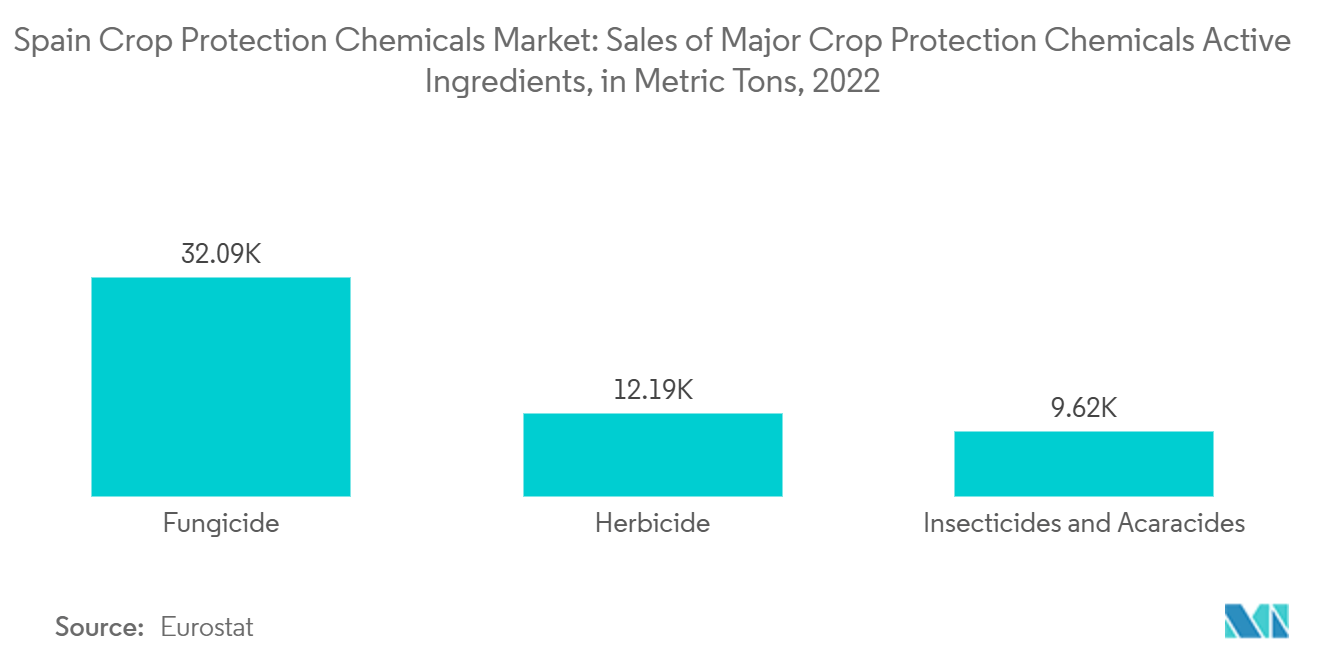Market Trends of Spain Crop Protection Chemicals Industry
Increasing Demand for Biopesticides
- In recent years, Spain has topped the charts in Europe for pesticide sales. Yet, sales across all pesticide categories have seen a notable decline. This trend aligns with Spain's commitment to the EU's Farm to Fork Strategy, aiming for a 50% reduction in the use and risk of synthetic pesticides by 2030. Consequently, this shift has set the stage for substantial growth in the biopesticides market.
- In November 2022, the European Commission rolled out a new legal framework designed to boost the accessibility of low-risk pesticides. This initiative prioritizes enhanced protection for farmers and consumers alike. Furthermore, this regulatory shift is set to benefit the organic cultivation of Nuts, Olives, Grains, and Grapes in the country. Data from the Ministry of Agriculture, Food and Environment in Spain reveals that Nuts dominate the organic land holdings, covering an impressive 290 thousand hectares.
- In July 2024, Syngenta introduced Pyrevert 5% EC, the market's most concentrated natural Pyrethrin. This product effectively manages pests, including aphids, whiteflies, thrips, cluster moths, leafhoppers, potato beetles, and vinegar flies. This launch aligns with the European Commission and the Spanish government's active promotion of biopesticides. In response to these initiatives, key market players are unveiling new products to support farmers in achieving efficient pest management.

The Fungicides Segment is Dominating the Market
- European legislation surrounding the renewal and registration of active substances and phytosanitary products has grown more complex and stringent. Consequently, several active materials are not being renewed, and the registration of new molecules has become increasingly difficult. This shift is resulting in fewer solutions available for European agriculture. Although the fungicide segment currently dominates the market, sales of fungicide active ingredients saw a significant drop of 23% in 2022 compared to the previous year. In 2022, Spain's sales of fungicide active ingredients reached 32,094.3 metric tons.
- In Spain, rising fungal attacks on key crops are fueling the demand for fungicides. In 2024, avocado producers in Spain grapple with the escalating challenges posed by the dieback fungal disease. Dieback initiates at the tips of branches, leading to a gradual die-off of those branches and the formation of cankers on the tree's stem. Historically, dieback has been a concern primarily for Malaga and its neighboring regions. However, over the last 3-4 years, other avocado-growing regions in Spain, including Comunidad Valenciana and Cadiz, have raised alarms. Previously, only a handful of branches would show infection. But in 2024, numerous farmers are witnessing dieback jeopardizing up to 50% of their trees, resulting in a significant dip in commercial yields. With the judicious application of fungicides, there's potential not only to halt the disease's spread but also to mitigate production losses.
- Spain, a leading producer of olives and olive oil, has allocated 2.4 million hectares of land to cultivate this prized crop. Yet, in 2023, olive production faced a notable downturn, primarily due to drought conditions. Compounding this challenge, the threat of anthracnose—a virulent fungal disease prevalent in Spain—looms large. This disease can inflict an average annual crop loss of 2.6%. As a result, there's an anticipated uptick in the use of appropriate fungicides, underscoring the rising demand for fungicides in oilseed crops to counteract potential production declines.


